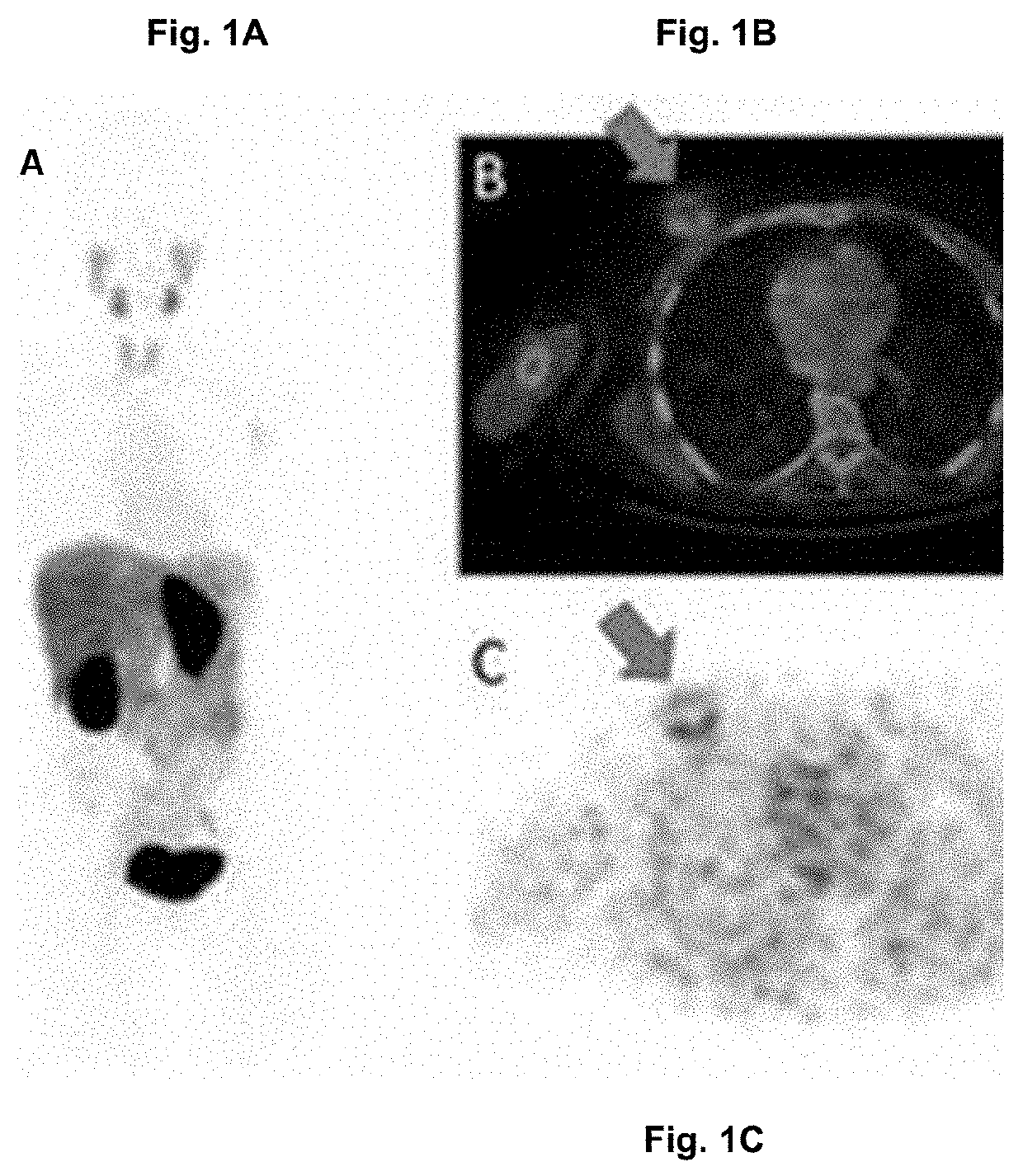Radio-labelled antibody fragments for use in the prognosis, diagnosis of cancer as well as for the prediction of cancer therapy response
a radio-labelled antibody and cancer technology, applied in the field of radio-labelled antibody fragments, can solve the problems of difficult early detection, unreliability, and low sensitivity of these markers, and achieve the effects of low healthy tissue uptake value, fast clearance from the blood, and high tumor uptake valu
- Summary
- Abstract
- Description
- Claims
- Application Information
AI Technical Summary
Benefits of technology
Problems solved by technology
Method used
Image
Examples
example 1
ry Analysis of Phase I Study of 68Ga-HER2-Nanobody (68Ga-Anti-HER2 VHH) for PET / CT Assessment of HER2-Expression in Breast Cancer
[0320]The primary objective of this study was the assessment of safety, human biodistribution and dosimetry as well as the evaluation of tumor uptake in HER2-expressing lesions in breast carcinoma patients.
[0321]Methods
[0322]The anti-HER2 VHH (SEQ ID NO:4) was labeled with 68Ga via a NOTA derivative (pSCNBnNOTA) with >97% radiolabeling yield after 5 min at RT. In total, 15 female patients with breast carcinoma lesions showing intermediate or high HER2 expression on immunohistochemistry were studied (9 / 15 showed amplification on FISH analysis).
[0323]In one patient, the entire tumor lesion had been removed at the primary biopsy. Among the FISH negative patients, 4 / 5 still showed VHH uptake. Thus, VHH imaging can identify patients that may benefit from Her2-targeted diagnosis despite an initial FISH negative score (i.e. to “fish” for false FISH negative patie...
example 2
Analysis of Phase I Study of 68Ga-HER2-Nanobody (68Ga-Anti-HER2 VHH) for PET / CT Assessment of HER2-Expression in Breast Cancer
[0333]In the remaining examples sections the term VHH or VHH domain is used interchangeably with the term Nanobody (Nb).
[0334]All terms 68Ga-HER-Nanobody, 68Ga-NOTA-anti-HER2 Nanobody and 68Ga-anti-HER2-VHH on the one hand; HER-Nanobody, anti-HER2-Nanobody, HER2-VHH and anti-HER2-VHH on the other hand, refer to the same compound (either labelled with 68Ga or unlabeled).
[0335]Methods
[0336]In total, 20 female patients with primary or metastatic breast carcinoma (HER2 IHC 2+ or 3+) were included. Anti-HER2-Nanobody is labeled with 68Ga via a NOTA derivative. Administered activities were 53-174 MBq (average 107 MBq). PET / CT scans (for dosimetry assessment) were obtained at 10, 60 and 90 min post administration. Physical evaluation and blood analysis were performed for safety evaluation. Biodistribution was analyzed for 11 organs using MIM software; dosimetry was ...
example 3
tal Data for the Phase I Study of 68Ga-HER2-Nanobody (68Ga-Anti-HER2 VHH) for PET / CT Assessment of HER2-Expression in Breast Carcinoma
[0378]Supplemental methods in addition to the details set out in Example are set out hereunder.
[0379]Approvals
[0380]The Belgian federal agency for medicines and health products, the regional ethics committee of UZ Brussel and the radiation protection agency of Belgium approved this study. The study was conducted in accordance with the Declaration of Helsinki and the International Conference on Harmonization Guidelines for Good Clinical Practice. Written informed consent was obtained from all participants. The study was registered as a clinical trial with the identifier EudraCT 012-001135-31.
[0381]Patient Characterization and Study Subgroups
[0382]Twenty adult female breast carcinoma patients with local, locally advanced or metastatic breast carcinoma that showed a moderate or high expression of HER2 on immunohistochemistry (2+ or 3+) were included in t...
PUM
| Property | Measurement | Unit |
|---|---|---|
| dissociation constant | aaaaa | aaaaa |
| dissociation constant | aaaaa | aaaaa |
| dissociation constant | aaaaa | aaaaa |
Abstract
Description
Claims
Application Information
 Login to View More
Login to View More - R&D
- Intellectual Property
- Life Sciences
- Materials
- Tech Scout
- Unparalleled Data Quality
- Higher Quality Content
- 60% Fewer Hallucinations
Browse by: Latest US Patents, China's latest patents, Technical Efficacy Thesaurus, Application Domain, Technology Topic, Popular Technical Reports.
© 2025 PatSnap. All rights reserved.Legal|Privacy policy|Modern Slavery Act Transparency Statement|Sitemap|About US| Contact US: help@patsnap.com



